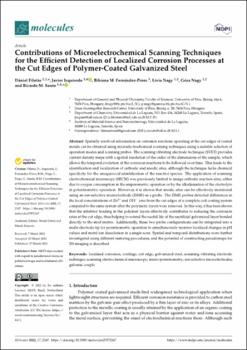Contributions of microelectrochemical scanning techniques for the efficient detection of localized corrosion processes at the cut edges of polymer-coated galvanized steel. D. Filotás, J. Izquierdo, B.M. Fernández-Pérez, L. Nagy, G. Nagy, R.M. Souto.
Fecha
2022Resumen
Spatially resolved information on corrosion reactions operating at the cut edges of coated
metals can be obtained using microelectrochemical scanning techniques using a suitable selection of
operation modes and scanning probes. The scanning vibrating electrode technique (SVET) provides
current density maps with a spatial resolution of the order of the dimensions of the sample, which
allows the temporal evolution of the corrosion reactions to be followed over time. This leads to the
identification and localization of cathodic and anodic sites, although the technique lacks chemical
specificity for the unequivocal identification of the reactive species. The application of scanning
electrochemical microscopy (SECM) was previously limited to image cathodic reaction sites, either
due to oxygen consumption in the amperometric operation or by the alkalinisation of the electrolyte
in potentiometric operation. However, it is shown that anodic sites can be effectively monitored
using an ion-selective microelectrode (ISME) as a probe. The ISME probes detected differences in
the local concentrations of Zn2+ and OH− ions from the cut edges of a complete coil coating system
compared to the same system after the polymeric layers were removed. In this way, it has been shown
that the inhibitor loading in the polymer layers effectively contributes to reducing the corrosion
rates at the cut edge, thus helping to extend the useful life of the sacrificial galvanized layer bonded
directly to the steel matrix. Additionally, these two probe configurations can be integrated into a
multi-electrode tip for potentiometric operation to simultaneously monitor localized changes in pH
values and metal ion dissolution in a single scan. Spatial and temporal distributions were further
investigated using different rastering procedures, and the potential of constructing pseudomaps for
2D-imaging is described.






